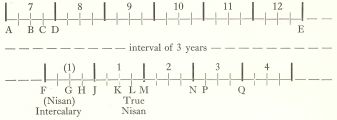Chapter 6 - 1260—1290—1335
In chapter 5 it was suggested that whilst there
are big difficulties in the way of applying the “year for a day”
theory to the “time, times and a half” of Daniel, there is on the
other hand fair evidence for taking this period as 3½ literal
years—the final time of trouble for Israel before the manifestation of
their Messiah.
But Daniel 12 not only has this 31 times, or 1260
days. It also mentions 1290 and 1335 days. If the interpretation of the 1260
days advocated here is correct, it should be possible to find a special
significance in the extra 30 and 75 days, which these other periods require. At
the same time even if the attempt to seek out the meaning of these extra periods
fail, it need not follow that the idea of a literal 3~ year time of trouble at
the End is necessarily proved to be mistaken. It may well be that at present
there is inadequate insight into these divine mysteries.
The following represents an attempt to fill out
the details:
First, it is necessary to remind the reader that
the Jewish year, consisting of lunar months, which average 29½ days each,
really included only 354 days (292 x 12). Because of this accumulating error of
111 days per year, the Jewish calendar got steadily out of step with the
seasons. This problem was coped with by a remarkably simple device, that of the
Intercalary month. The Passover feast to the springtime barley harvest tied the
Jewish calendar, because (Leviticus 23:10,11) on the day after the Passover
Sabbath the first-ripe sheaf of barley was to be offered before the Lord. So if
when Passover was approaching it became evident that the barley could not be
ripe in time for the 16th Nisan, an extra month (the intercalary month) was
slipped into the year before Nisan began. Thus every three years or so, an
intercalary month was necessary. This fact helps to solve a difficulty in
connection with the 1260, 1290, 1335 days.
AE = last 6 months of a certain year, date
unknown.
ABCD = the 7th month.
A = the Feast of Trumpets.
BC = the Feast of Tabernacles.
E—F = an interval (not easily possible of
representation on this page) of 3 ordinary years.
FQ = the first 4 months of the ensuing
year.
A period of 1260 days (42 lunar months and 21
days) measured from A, the Feast of Trumpets, ends at H, which would normally be
the end of the Feast of Unleavened Bread, a week after Passover G. But this
period includes the accumulating error of four full years. Thus an intercalary
month is necessary here. The month FJ has to fill this role, thus making JM the
True Nisan for this particular year. The 1290 days finish at L, the end of the
true Feast of Unleavened Bread.
And now the 1335 days run on to P, which is
precisely the Feast of Pentecost.
Thus all three periods are seen to slip neatly
into the Jewish calendar. And since the prophecies of Daniel are about Israel
and Israel’s relations to the great powers of the world (and not about
Moslems), this kind of conclusion is almost to be expected a
priori.
A close look at these details provides good
reason for these particular feasts being chosen by God as key points in His
time-table for the final deliverance of Israel.
Why should the 1260 begin from the Feast of
Trumpets (Leviticus 23: 24)? Because this feast and the blowing of trumpets is
specially associated in Israel’s history with the proclaiming of the Law
of God. See Nehemiah 8:2; Exodus 19:16, 19; Amos 3: 6, 7; Psalms 81: 3, 4, 8,
13, 14. This period of 32 years will later equate (chapters 7, 8) not only with
the time of Jacob’s trouble but also with the time of Elijah’s
appeal to Israel and his summons to repentance.
The blowing of trumpets is also associated with
resurrection (1 Thessalonians 4:16; Matthew 24:31; Revelation 11: 15; 1
Corinthians 15:52). This 3½ year period marks the spiritual resurrection of
Israel, the true fulfilment of Ezekiel’s prophecy about the Valley
of Dry Bones.
Why should the 1290 days end with the Feast of
Unleavened Bread? Because now is the time when Israel ceases to eat “the
bread of affliction” (see Deuteronomy 16:3). From this date forward
“the abomination that maketh desolate” is no more set up in their
Land (Daniel 12:11).
And why should the 1335 days end at Pentecost?
Because it is the time of bestowal of the Holy Spirit. It was at Pentecost that
Peter quoted to the assembled multitude of Jews the words of Joel 2 :28,
29—which prophecy has another fulfilment awaiting it in future days
besides that which Jerusalem witnessed then. Wherefore—”blessed is
he that waiteth, and cometh to the 1335 days”.

